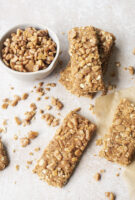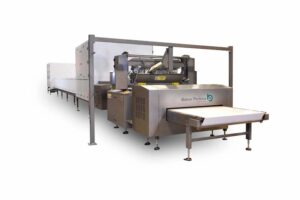Fudge, toffee and caramel: Creating modern nostalgia

pic: Fudge Kitchen
Daisy Phillipson examines the latest products, ingredients and machinery in the world of caramel, toffee and fudge, as nostalgic treats are reimagined with modern twists.
According to research group FMCG Gurus’ latest trends analysis for 2023, consumers are continuing to prioritise personal and environmental health and wellness with their food choices, including confectionery.
Concurrently, shoppers are concerned about the cost of living crisis as inflation reached a 40-year high in recent months. Mike Hughes, head of research and insight at FMCG Gurus, noted: “The key implication of this is that consumers will be reluctant to give up products that they deem essential and small luxuries, but at the same time, must be more mindful of spending.” As part of its research, the firm determined ten key trends for the rest of this year, many of which relate to health and wellbeing.
But as we saw with the pandemic, shoppers are also seeking permissible indulgences, especially as confectionery is a far more affordable luxury than other goods. This trend, named ‘Taste Temptation’, looks at how consumers will continue to seek out small indulgences for reward and escapism purposes as they reduce spending on big-ticket items. One flavour that ticks all of the boxes and has stood the test of time is caramel.
Analysis by Barry Callebaut shows that caramel ingredients and flavours have enjoyed steady growth in recent years. In fact, between 2015 and 2020, caramel was used in eight per cent of new product launches in the EMEA confectionery sector, according to Innova Market Insights.
The cocoa and chocolate group went on to highlight a number of reasons why caramel remains a fan favourite, including the fact that it brings comfort through nostalgia, it is loved across generations and it gives products a premium feeling. Alongside caramel, manufacturers are also experimenting with candy staples such as fudge and toffee to drive NPD, shaking up traditional formats with new tastes, textures and shapes to expand product ranges and drive interest.
Plant powered revolution
With the vegan revolution continuing to gather pace across the food and drink sector, confectionery manufacturers are playing a significant role in the sharp upturn in supply and demand. Findings by Grand View Research show the global vegan confectionery market size is expected to reach $2.62 billion by 2030, expanding at a CAGR of 11.8 per cent from 2022 to 2030. Although toffee, caramel and fudge products are traditionally made using some form of dairy product, a wide range of plant-based alternatives have been hitting the shelves in recent years, reflecting this projected growth.
A prime example is the aesthetic range from Jeavons Toffee, a small family business that handmakes all of its vegan toffees, caramels and chocolates using traditional methods. The company’s ethos addresses consumer desire to support local businesses and buy local. Additionally, its vegan twist on nostalgic and indulgent classics have proved a great success amongst its customers. Jeavons’ fully vegan range includes: Smootch, a packet of seven individual dairyfree chocolates with a toffee centre; Rabble, comprising two fingers of roasted peanuts in toffee, covered with chocolate; Rizo, a puffed rice, toffee and chocolate bar; and Caramel, a chunky bar of chocolate filled with caramel. Another company operating in this exciting sector is confectionery producer, Compels, which is known for its vegan Coconut Milk Caramels.
The company recently branched out with a new line featuring two SKUs: Oatmilk Chocolate-Covered Caramel Bites and Oatmilk Chocolate-Covered Toffee Bark. Just like the rest of Cocomels’ range, the products are vegan-friendly and free from corn syrup, palm oil and artificial ingredients, helping to tap into the desire for indulgent sweet treats that are better for personal and environmental health. Similarly, Fudge Kitchen’s premium, artisan collection uses 100 per cent natural ingredients, is free from palm oil and gluten, and the company is involved in sustainable and charitable initiatives.
While all of its range is vegetarian, Fudge Kitchen has been developing new vegan varieties, including its Toffee Vegan Fudge and plant-based Coconut Ice. While celebrating Veganuary, the company explained that most of the creaminess of its fudge comes from its unique sugar-crafting technique, meaning it can achieve the desired taste and texture using dairy alternatives.
Familiar yet fresh
Incorporating these flavours with inclusions is another way manufacturers can meet demand for nostalgic treats with exciting new twists. As explained by inclusions and decorations specialist Nimbus Foods, consumers are looking to create happy memories through food, especially in the current financial climate. One of the most popular desserts in the UK is sticky toffee pudding, which generates feelings of joy and nostalgia. Of course, the key ingredient is one that is enjoyed around the globe in an endless variety of formats. Nimbus describes how it produces toffee at its Dolgellau site every day, from toffee chips to toffee brittle and butterscotch. Twist Ingredients, which also produces decorations and inclusions, further highlights the interest in nostalgia-inducing recipes with modern updates.

Speaking about current trends and key products, the company’s joint director, Louise Gough, explains: “2023 is already set to be seeing the return of traditional bakes, but with a twist. As an industry, bakers seem to be wanting to experiment with more traditional flavours and bring back the nostalgia of eating such treats.” Twist’s salted caramel and fudge cubes are among some of its best-selling products as American-style flavours continue to gain traction.
“As the younger generation of bakers get involved with nostalgia-inducing bakes, we’re seeing a real mixture of traditional flavourings being paired with exciting new flavour combinations,” adds Gough. For consumers, chocolate is consistently at the forefront of innovation, with extravagant chocolate cakes, loaded brownies and cookie pies often featuring fudge inclusions or decorations. “Additional flavourings like salted caramel and fudge cubes are right at home when it comes to not only enhancing the flavours, but also making these bakes look incredible,” says Gough.
As for the production process, the machinery used to make caramel, toffee and fudge has changed drastically over the years in a bid to keep up with demand. Proform, whichdesigns and builds high performance confectionery production machinery, explains how a line for soft candy such as caramel and toffee would traditionally consist of a cooker, followed by a cooling drum or cooling belt. The mass might then have required maturation for several hours in a curing room, or the cooled mass might have been sent into a pulling machine or a Z-blade mixer for crystallisation. “From these machines, the mass was manually fed into one or split and sent into several down-stream forming lines,” commented Proform’s MD Christian Gand.
“This method is quite labour intensive, with operator intervention required to remove cooled product in bins, and take it to storage. Then, after maturation, an operator must take it for further processing and forming.” It’s no surprise that the industry has come a long way since then, as demonstrated by Proform’s automated and modern production lines. The Proform MI Intruder targets manufacturers of toffee or other soft candies looking to streamline their current production, improve results and increase automation. Just one of the company’s Intruders, which range from capacities of 350 to 1,100 kg per hour, is able to carry out four functions.
“Installed directly after the cooker, an Intruder can cool, grain or crystallise, add in ingredients and extrude several ropes, feeding down-stream forming lines,” says Gand. “One machine, our Intruder, replaces traditional production equipment: a cooling drum or cooling belt, as well as a pulling machine or a Z-blade mixer.” The machine also produces continuously, eliminating the need for intermediate product storage for curing or maturation. Ball Forming, Cut & Wrap or Die Forming lines are some of the downstream forming equipment that can be fed by the Intruder, with Gand adding: “After formng, the finished products can go directly to our client’s wrapping machines or to flow packers, as required by the process.”
The business goes on to explain that no cleaning is required with the Intruder for shutdown and restart when running the same product, even after several days of downtime or more. And for a changeover online, a pre-programmed procedure minimises product loss and can ensure a changeover from dark to light coloured products within less than three minutes.
Equipment group Baker Perkins also highlights the benefits of opting for modern systems over traditional processes, stating that its toffee and caramel cooking and depositing machinery provides manufacturers with greater product variety with high efficiency and output. Keith Graham, business development manager at Baker Perkins, says: “White toffee and traditional brown toffee can be enhanced with centre-fills, stripes, whirls, colours and flavours, providing exciting possibilities.”

Continuous production in a system integrated from ingredient feeding to cooled confectionery delivers increased efficiency, with the Microfilm cooker and Carablend carameliser being at the centre of the firm’s continuous systems for toffee and caramel products. “Using these unique units provides the flexibility essential to handle different ingredients, cooking temperatures and caramelising times, at high levels of automation and consistency,” reveals Graham. “Cooking and caramelising are carried out separately to give the flexibility and independent control needed for a wide selection of recipes.”
Additionally, Baker Perkins highlights its ServoForm soft confectionery depositor, describing how it was specifically designed to make high-quality toffee and caramel. As well as the ability to deposit distinct components with varying combinations of colours, textures, shapes and flavours, many manufacturers choose depositing technology over conventional methods due to the low cost of manufacture. “Compared with the traditional process, space, labour and maintenance costs are reduced, hygiene is improved and production cycles are cut,” concludes Graham, features which are made all the more valuable as manufacturers seek to meet consumer demand, while maintaining productivity



